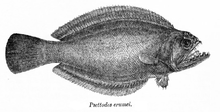| Spiny turbots | |
|---|---|
 | |
| Indian halibut (P. erumei) | |
| Scientific classification | |
| Domain: | Eukaryota |
| Kingdom: | Animalia |
| Phylum: | Chordata |
| Class: | Actinopterygii |
| Order: | Carangiformes |
| Suborder: | Pleuronectoidei |
| Family: | Psettodidae Regan, 1910 |
| Genus: | Psettodes E. T. Bennett, 1831 |
| Type species | |
| Psettodes belcheri Bennett, 1831 | |
The spiny turbots are a family, Psettodidae, [1] of relatively large, primitive flatfish found in the tropical waters of the east Atlantic and Indo-Pacific. [2] The family contains just three species, all in the same genus, Psettodes. The common name comes from the presence of spines in the dorsal and anal fins, which may indicate an evolutionary relationship with the Perciformes. They are less asymmetrical than other flatfish, although the region around the eyes is twisted. [3] They reach lengths of 55–80 cm (22–31 in). [4]




